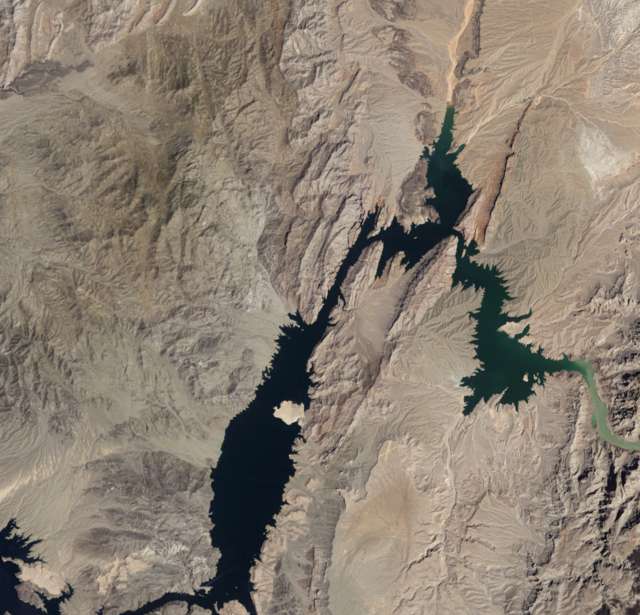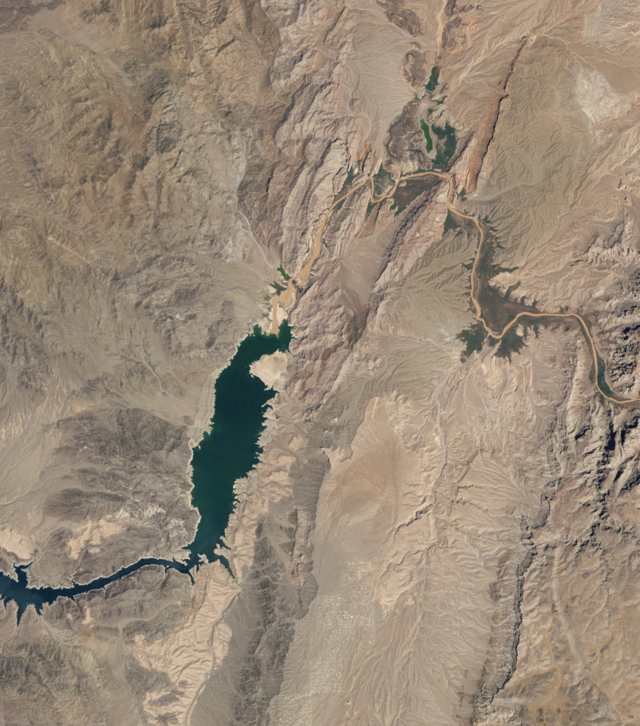Lake Mead (1958):
Lake Mead (2010):
Via the Earth Observatory.
These two starkly different and somewhat frightening images don’t represent a linear diminishment of Lake Mead. Instead, they are two extremes on a naturally fluctuating water level:
This fluctuating water level isn’t, further, a natural problem. It has, however, become an increasingly social problem. It provides water for the Southwest, a portion of the country that has become thirstier and thirstier. From Maggie Koerth-Baker at BoingBoing:
Take, for instance, Las Vegas, which gets 90 percent of its water from Lake Mead. Back in the 1940s, fewer than 9,000 people lived there. In 2006, the population was estimated at more than 550,000, and growing. Rapidly.
This makes large numbers of people vulnerable to these natural fluctuations in ways that they never were before and potentially creates human disasters out of our own poor planning and resource management. If climate change exacerbates this problem, and it very well might, then the reliability of our water supply is even more fragile.
Lisa Wade, PhD is an Associate Professor at Tulane University. She is the author of American Hookup, a book about college sexual culture; a textbook about gender; and a forthcoming introductory text: Terrible Magnificent Sociology. You can follow her on Twitter and Instagram.



Comments 13
Shannon — October 5, 2010
Have a look at satellite pictures of the Aral Sea!
http://www.gly.uga.edu/railsback/FieldImages/AralSea.jpeg
gasstationwithoutpumps — October 5, 2010
Talking about the "natural" fluctuation of an artificially created lake raises some cognitive dissonance for me. There is a natural fluctuation in rainfall and overuse of water resources (to the point where the Colorado River no longer reaches the ocean), both of which are stories worth telling, but the fluctuation of water level in a reservoir doesn't seem to me to tell either story well. (For that matter, the overhead view does not clearly show the volume change, as we have no way of telling how steeply the bottom slopes.)
Molly — October 5, 2010
Very interesting. But the original website says the first picture was taken in 1985, NOT 1958.
Also of interest may be what the river looks like by the time it reaches the ocean, and how our water use has affected those living in Mexico: http://visibleearth.nasa.gov/view_rec.php?id=1661
Phoebe — October 5, 2010
Without even doing a real analysis (with numbers) I can tell this doesn't fit a "natural fluctuation". For one, it was the lowest ever in August 2010, and has been diminishing. It looks like the cycles are every five years (I'm not a meterologist, so that makes no sence to me because why would there be a cycle based on years not months, unless it has something to do with El Nino).
"Lake Mead's water level has three times fallen below the drought level (1125 feet above sea level). From 1953 to 1956, the water level fell from 1200 feet to 1085 feet. From 1963 to 1965, the water level fell from 1205 feet to 1090 feet. Since 2000 through 2008, the water level has dropped from 1215 to 1095."
(http://en.wikipedia.org/wiki/Lake_Mead)
This current drought is by far the longest. And the deepest. Weather this has to do with the increasing population or the insane temperatures, I'm not sure.
Jeff Kaufman — October 5, 2010
I'm confused: don't we draw more from lake mead than we used to? By a lot? Wouldn't we want to talk about the amount of rain in a year instead of the amount of water present in the lake to talk about cycles of drought?
Alison — October 5, 2010
I'm also confused, for different reasons. Is the argument here that human settlements are misusing resources, or is it that other, possibly, possibly global, environmental changes are altering the water level?
Ricky — October 6, 2010
I am also confused. Why is this considered a disaster? Just because the water level is low? The reservoir is doing what it was designed to do. There is water available that would have been wasted if the dam had not been built.
jmack — October 7, 2010
The population of Las Vegas is 600,000 today but if you include the metro area, it exceeds 2 million. This is not including tourists that double the city proper's population every summer. In 1990, when I lived there, water management was non-existent. They had already emptied one underground aquifer before (new) hotels were required to install low-flow toiilets and showerheads. With an average 11' of rainfall a year, this won't help the reservoir much.
The Southern Nevada Water Authority (formerly the LVWA) (aka Blithering Idiots) have a plan: run thousands of miles of pipeline to drain underwater aquifers in northern Nevada and beyond to drain the Great Lakes. Brilliant!
Ben Zvan — October 13, 2010
This is an excellent illustration of why Hoover Dam was built in the first place. Natural fluctuations in rainfall were causing seasonal droughts that were worse in some years than in others. Lake Mead evens out the fluctuations of available water in the river by holding back water in the flush times and letting it out in the drought times. You can argue whether or not this was a good idea ecologically, but Hoover Dam generates an incredible amount of remarkably green energy.